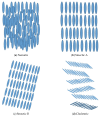Nanostructured Color Filters: A Review of Recent Developments
- PMID: 32784749
- PMCID: PMC7466596
- DOI: 10.3390/nano10081554
Nanostructured Color Filters: A Review of Recent Developments
Abstract
Color plays an important role in human life: without it life would be dull and monochromatic. Printing color with distinct characteristics, like hue, brightness and saturation, and high resolution, are the main characteristic of image sensing devices. A flexible design of color filter is also desired for angle insensitivity and independence of direction of polarization of incident light. Furthermore, it is important that the designed filter be compatible with the image sensing devices in terms of technology and size. Therefore, color filter requires special care in its design, operation and integration. In this paper, we present a comprehensive review of nanostructured color filter designs described to date and evaluate them in terms of their performance.
Keywords: color filters; liquid crystal display; mie scattering; nanoholes; photonic crystals.
Conflict of interest statement
The authors declare no conflict of interest.
Figures











References
-
- Wyszecki G., Stiles W.S. Color Science: Concepts and Methods, Quantitative Data and Formulae. John Wiley & Sons; Hoboken, NJ, USA: 1982.
-
- Bayer B.E. Color Imaging Array. 3971065. US Patent. 1976 Jul 20;
-
- Meth-Cohn O., Smith M. What did W. H. Perkin actually make when he oxidised aniline to obtain mauveine? J. Chem. Soc. Perkin Trans. 1. 1994;1:5–7. doi: 10.1039/p19940000005. - DOI
-
- Meléndez-Martínez A.J., Britton G., Vicario I.M., Heredia F.J. Relationship between the colour and the chemical structure of carotenoid pigments. Food Chem. 2007;101:1145–1150. doi: 10.1016/j.foodchem.2006.03.015. - DOI
Publication types
Grants and funding
LinkOut - more resources
Full Text Sources

